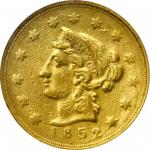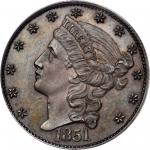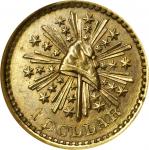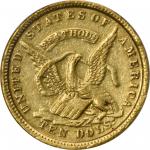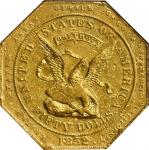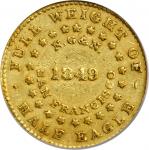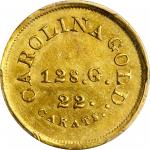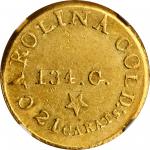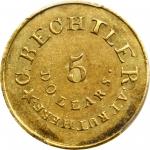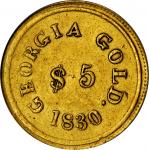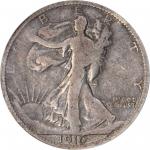Uniface 1850 Dubosq & Co. $5 reverse die trial. K-3a. Rarity-8. White metal. MS-64 (ANACS). OH.The soft steel gray surfaces of the white metal retain their high reflectivity with crystal clear and sharp devices and an especially bold eagle. There is only a small as-made spot of irregularity at the lower right that does not affect any of the design or legends and is part of the production process. The paper backing on the reverse is clean and undamaged. A crisp and clean example worthy of only the finest specialist cabinet.Theodore Dubosq, Sr. started out as a jeweler and silversmith before deciding to venture West in January of 1849 on board the Grey Eagle. The January 18, 1849 edition of the Philadelphia Evening Bulletin recorded that, Mr. Theodore Dubosq, Sr., jeweler, North Second Street, we understand takes out with him the machinery for melting and coining gold, and stamping it with a private mark, so as to establish a currency which will afford the greater convenience and facility for dealing in the raw material. Dubosq arrived in San Francisco on May 18 and set to work establishing his private mint and assay office, producing some trial coins dated 1849. In early 1850, Dubosq formed a partnership with a Mr. Goodwin, and this is seemingly the start of the Dubosq & Co. operations. The coins dated 1850 were produced from finely worked dies that very closely resemble Gobrechts Coronet half eagles, differing primarily in the wording, with DUBOSQ & CO. on Libertys headband and the reverse bearing the legend S.M.V. [Standard Mint Value] CALIFORNIA GOLD. The dies were so carefully produced that it is conjectured (though not proven definitively) they may have been cut by James Longacre, a theory bolstered by the pair of die trials found in his estate. These die trials (or splashers) were struck in soft and rather brittle white metal to test new dies prior to putting them into active use without putting them to excessive stress and backed with paper at the time of striking to hold the planchet together. In early 1851, the Daily Alta California reported that some $150,000 coins in $5 and $10 denominations were struck by Dubosq & Co. The coins enjoyed some early success in commerce and circulated widely. However, the end of the Dubosq coins came with the publication of an assay report from Augustus Humbert in 1851 who reported that the $5 gold piece only contained $4.96 worth of gold. Even though Dubosq accurately countered that the value of the silver contained in the alloy rendered the coins worth more than their face value, the damage had been done. The poor assays from other private coiners helped contribute to a heavy distrust of all such coins. Almost all the privately issued gold coins in circulation save for the extensive issues of Moffat & Co. were soon quickly discredited and melted down. The reverse dies ended up with Wass, Molitor & Co. who used one such die in 1852 for their own issue of $10 gold pieces. Today the Dubosq & Co. coins are some of the most sought-after rarities of any pioneer and territorial issue, with several of even these precious few survivors permanently impounded in institutional collections. The die trials themselves are equally as rare and seldom ever cross the block. Given the extraordinary rarity of the final product in gold, these die trials are among the few ways collectors can ever add a Dubosq & Co. numismatic item to their holdings. An important relic from a legendary territorial gold issue.From the Samuel J. Berngard Collection.


